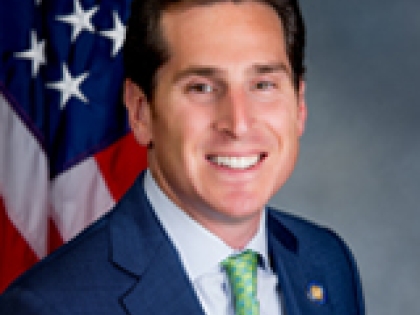
Sen. Kaminsky Plans Private Meeting Ahead Of Water Quality Forum
LONG BEACH, NY — Democratic state Sen. Todd Kaminsky plans to meet privately with city stakeholders at his office Thursday about improving the Long Beach water infrastructure. The meeting comes ahead of a planned public forum that Kaminsky helped organize, where city, state and county officials will talk about the recent water emergency and take questions from the community.
The two meetings come after a strain of E. coli was detected last month in the city's water supply and subsequent complaints that elevated chlorine levels used to flush the system were burning peoples' eyes, irritating their skin and more.
Kaminsky, a Lido Beach native who now lives in Long Beach, on Tuesday declined to name the people he would be meeting with Thursday, but noted they could inform him about the city's views on water quality, as well as on costs, how to upgrade the infrastructure and gaining access to state resources to facilitate that process.
The water quality issue is "critically important,"said Kaminsky, who helped organize the July 24 public forum. The issue affects him personally. The senator has two kids, ages 1 and 4, and his family drinks the tap water. He also represents the city's roughly 35,000 residents.
"Everyone now is putting a cup to their lips wondering if it's safe to drink," he said.
Kaminsky declined to say whether he could taste chlorine in his home drinking water, noting he is not an expert on the topic. The forum he helped organize aims to answer questions swirling about what led to the bacteria detection, how to prevent it from happening again and whether the ensuing treatment was problematic. He also hopes it will shed light on the state of the water infrastructure.
"I wanted to bring everyone together for it because Long Beach residents have important questions about a vital resource," he said. "I know not just a few, but a lot of families who won't drink the tap water anymore since the E. coli scare."
A question-and-answer session is planned at the public meeting, according to an event flyer. The event will begin at 6 p.m. on the 6th floor of the Long Beach City Hall and end at 9 p.m. Representatives with the city's Public Works department are expected to attend, as well as others from the county Health Department and the state Health Department. Kaminsky also expects county Executive Laura Curran, Legislator Denise Ford and assemblywoman Melissa "Missy" Miller will be in attendance.
"There was a lot of talk about water during the three-day emergency and after that just a big silence," he said.
Kaminsky is homing in on the city's brown and discolored water, as well as its aging water infrastructure, particularly given that residents pay high water bills and taxes. He wants to know what the plan is to upgrade the infrastructure, such as water storage tanks, pipes or equipment.
"Some of it is over 100 years old," he said. "Obviously that needs to be addressed."
Water ought to be at the forefront of any budget city officials put together, he said, and as a state lawmaker, Kaminsky plays a role in unlocking various resources at the city's disposal to help accomplish this. This includes various state grants for water infrastructure improvement. Kaminsky stressed that a plan must be in place in order to get that funding, as well as a proper application and desire to see the project through. The city would put that application together, something Kaminsky would be happy to help with.
John Mirando, commissioner of the city's Public Works department, told Patch last week there are 55 miles of water main in Long Beach, much of which dates back 100 years. When they were originally installed, the city used cast iron pipes. Because water is corrosive, rust builds inside the older water mains. Once there's a "disturbance" in the older pipes — such as when a fire hydrant is opened — that affects the aging active pipes, and some of that rust slips off, causing the discoloration.
But that's all it is. It's harmless, he said.
"It's not dangerous, it's not unhealthy," Mirando said. "It has nothing to do with any bacteria or anything like that."
When those mains are replaced today, the city uses ductile iron lines lined with cement to prevent the discoloration. More than 10 miles of cast iron water main have been replaced since 1986.
"In those areas you don't get discolored water complaints," said Mirando.
Two more replacement projects are planned this year, and they're not cheap. Replacing 1,500 feet of pipes costs about $1 million, making it prohibitively expensive to replace all the mains at once.
The city flushes the water system twice a year at night to get rid of any sediment in the water mains, Mirando said. This happens once in November and once in May. The department had to do it when chlorine levels were added too, which likely caused some discoloration, he said.
Moreover, many apartments, homes and condos have internal plumbing issues, he said, often stemming from hot water heaters and large boilers. Hot water becomes unstable and iron can seep into the water. This, too, can lead to discoloration.